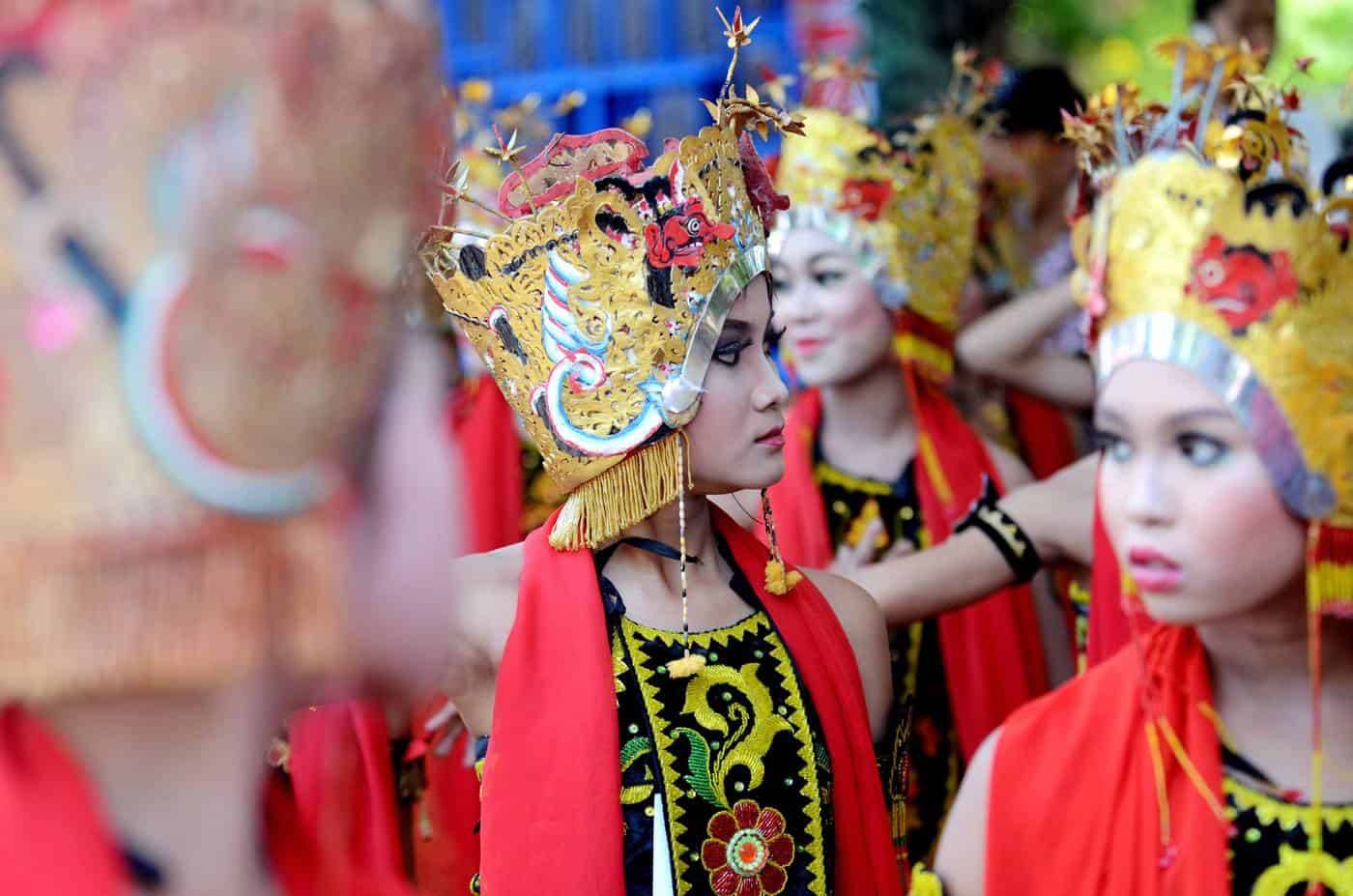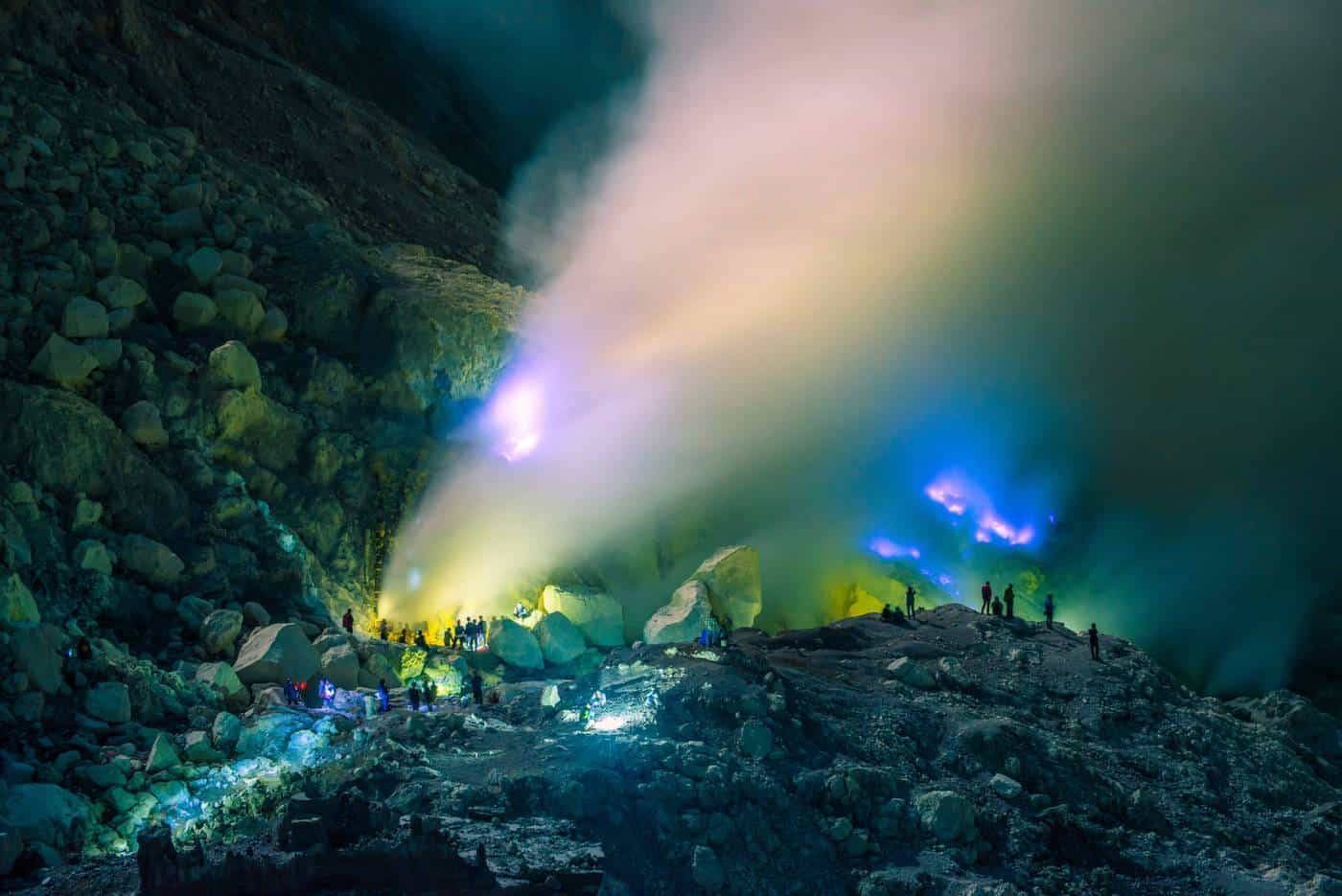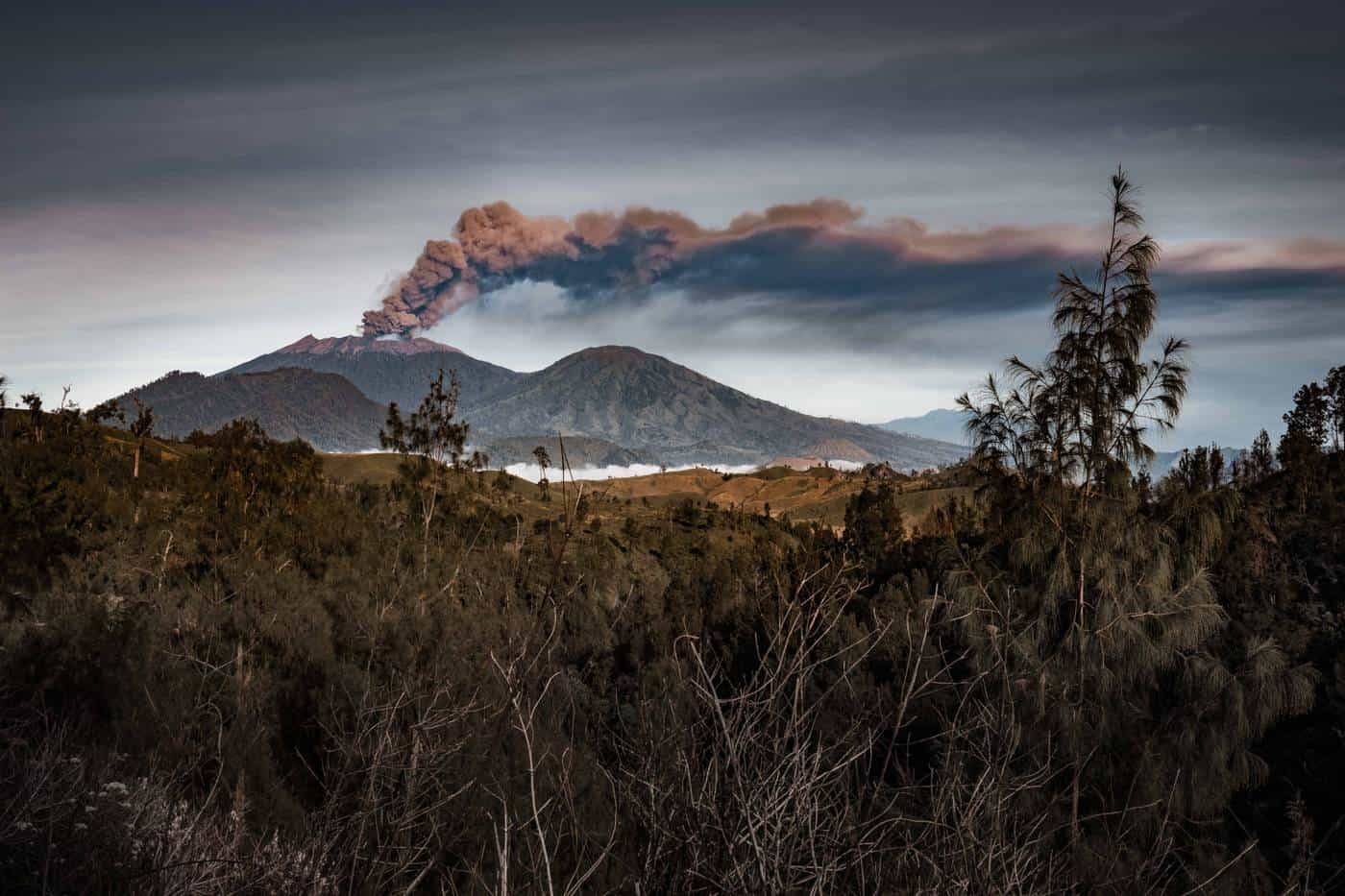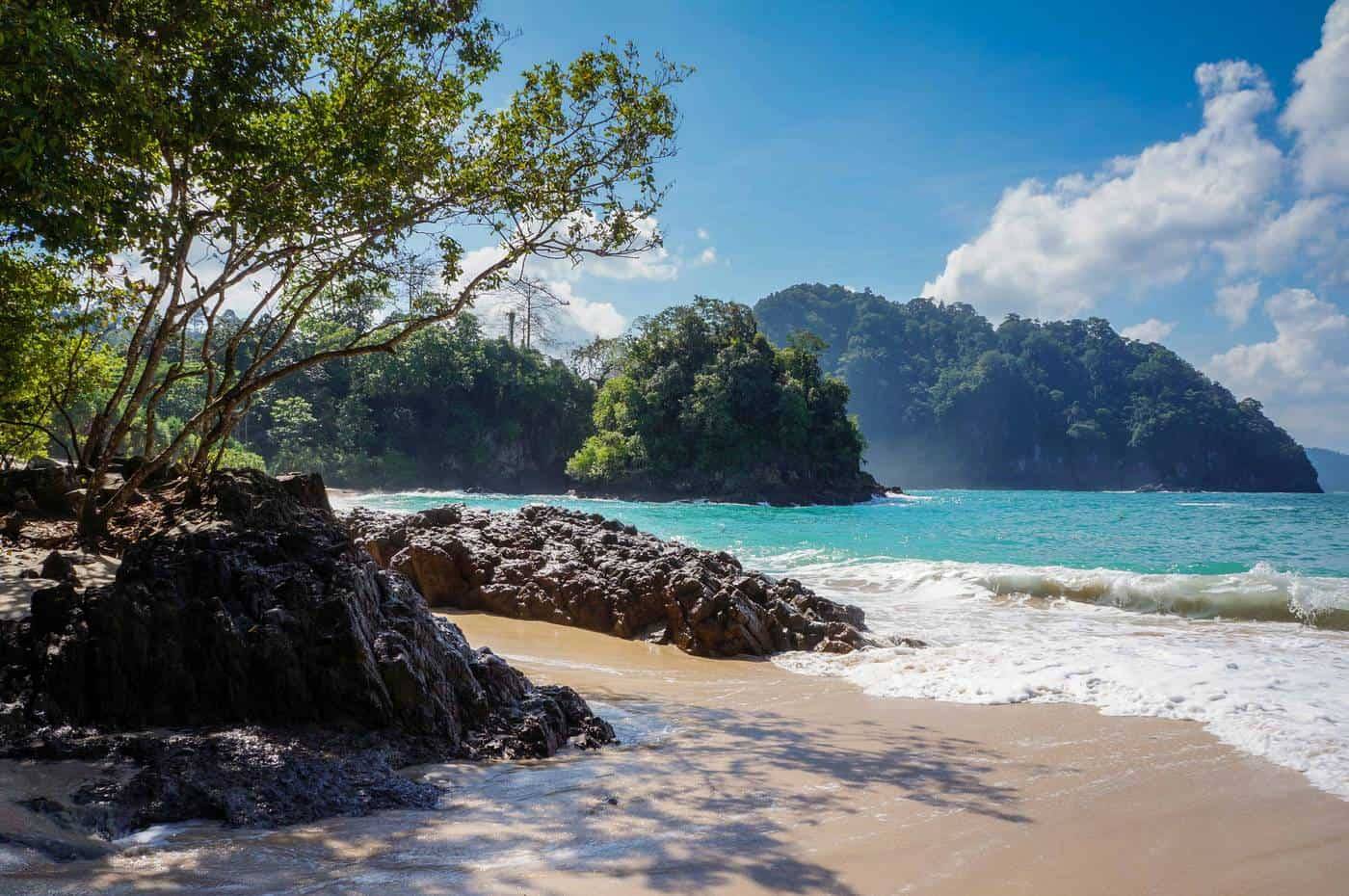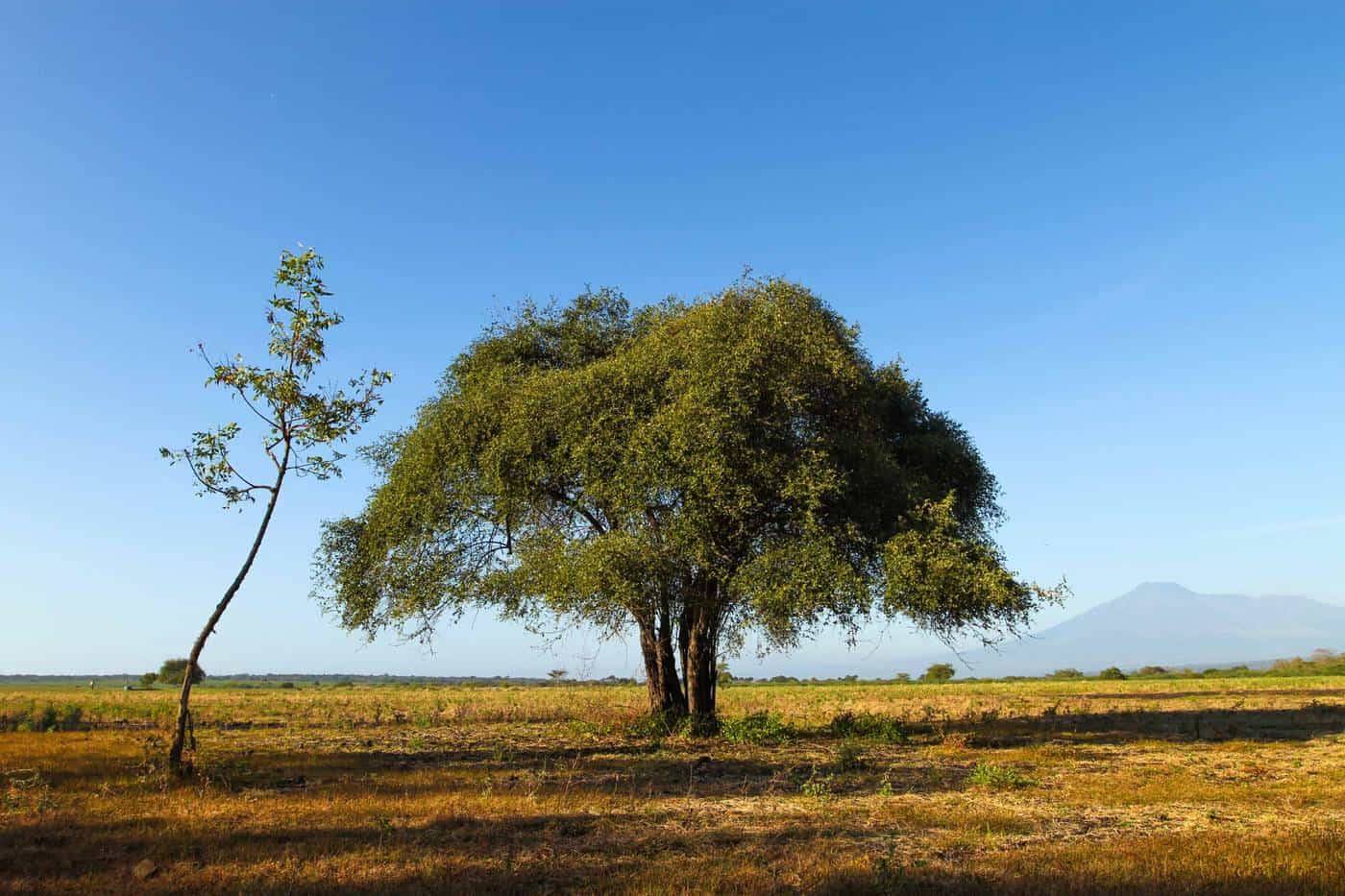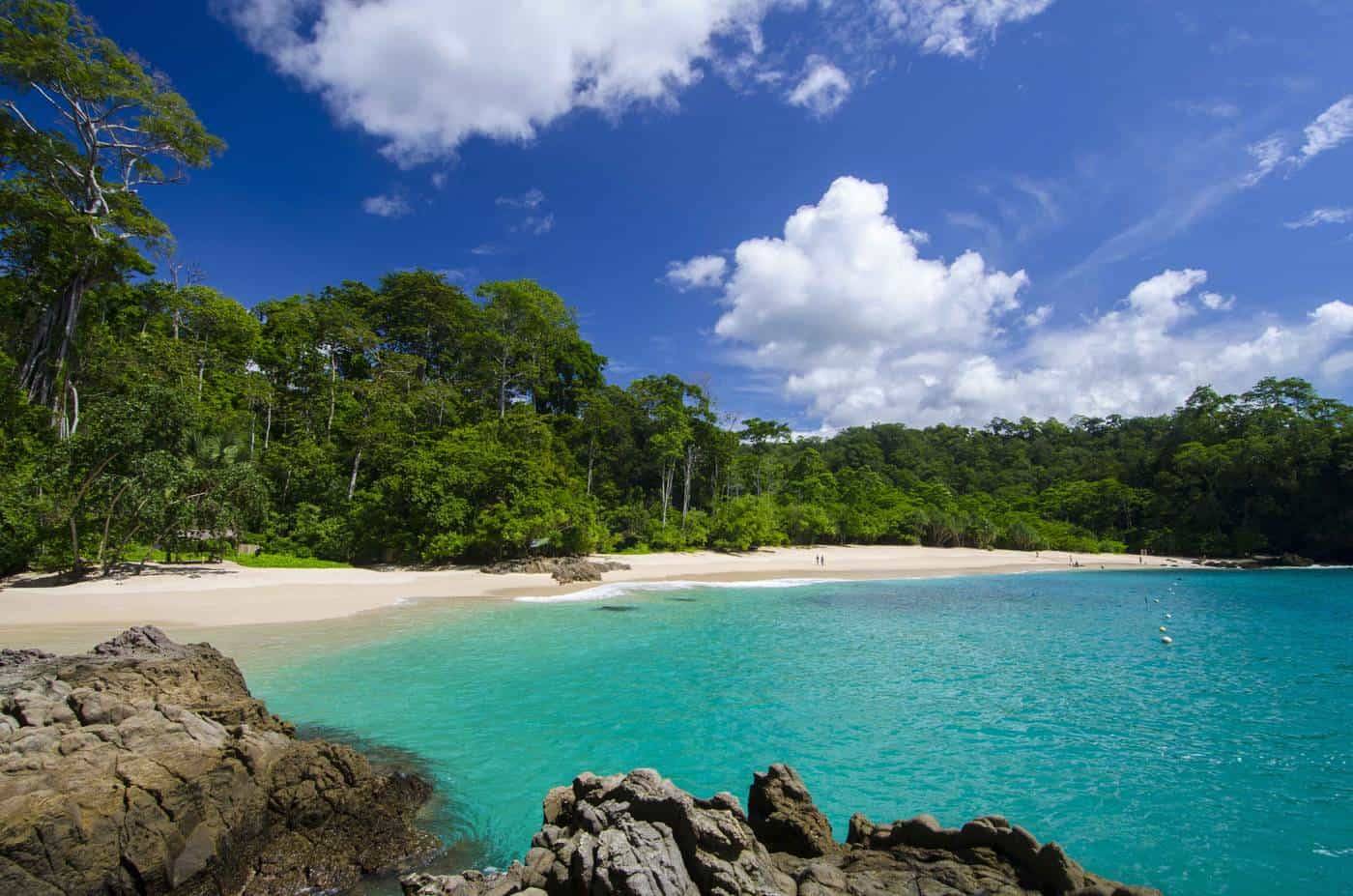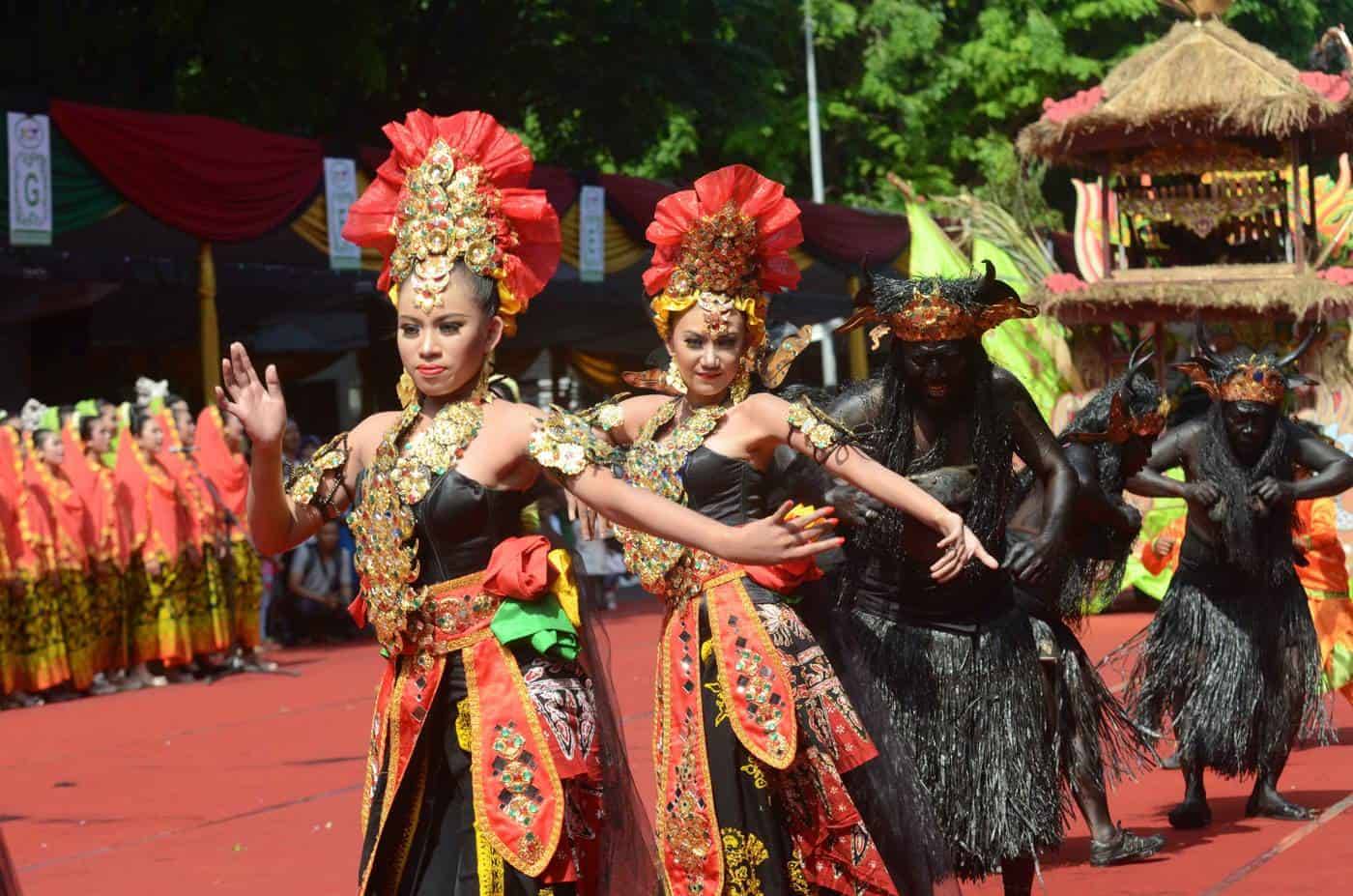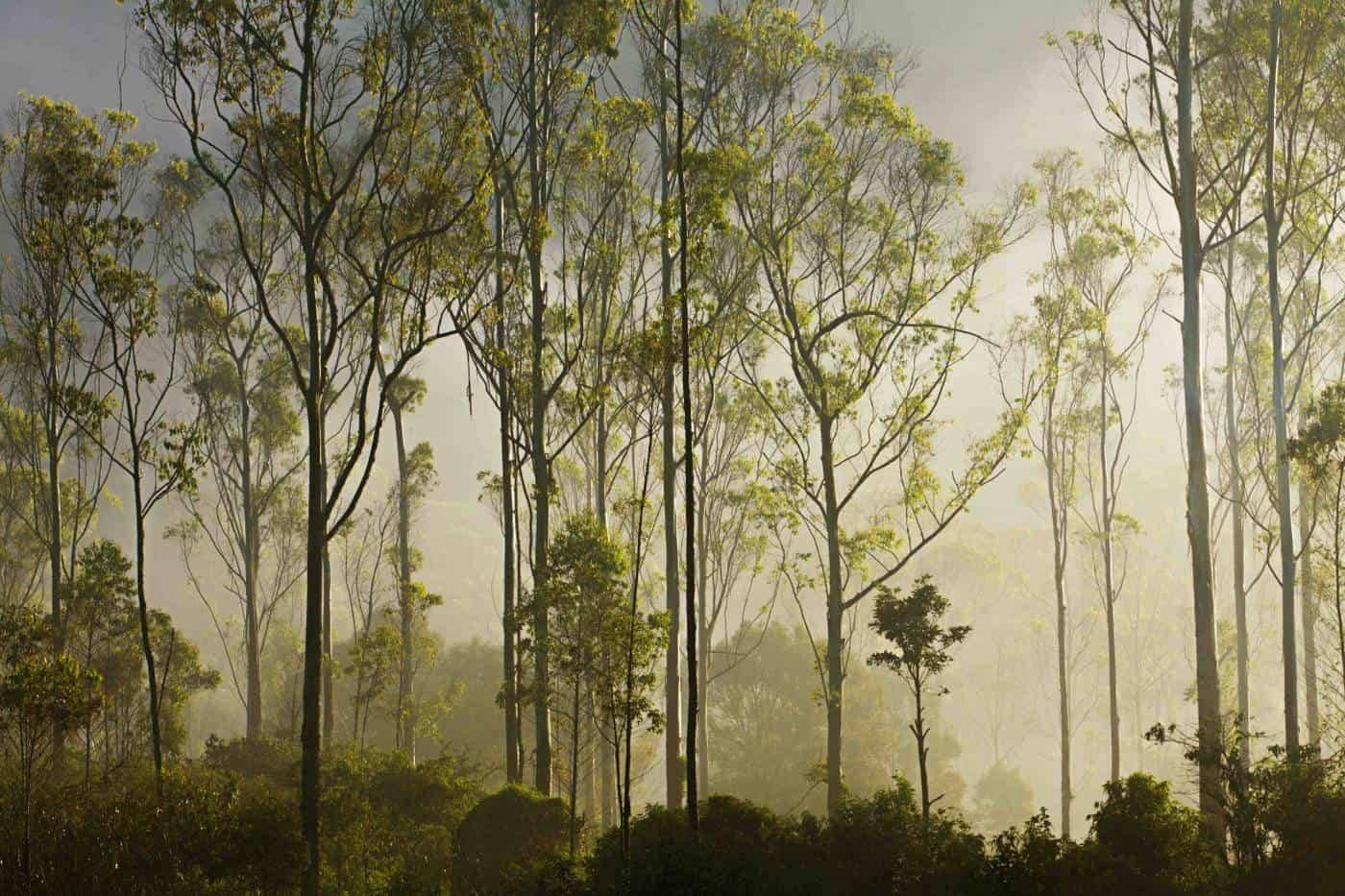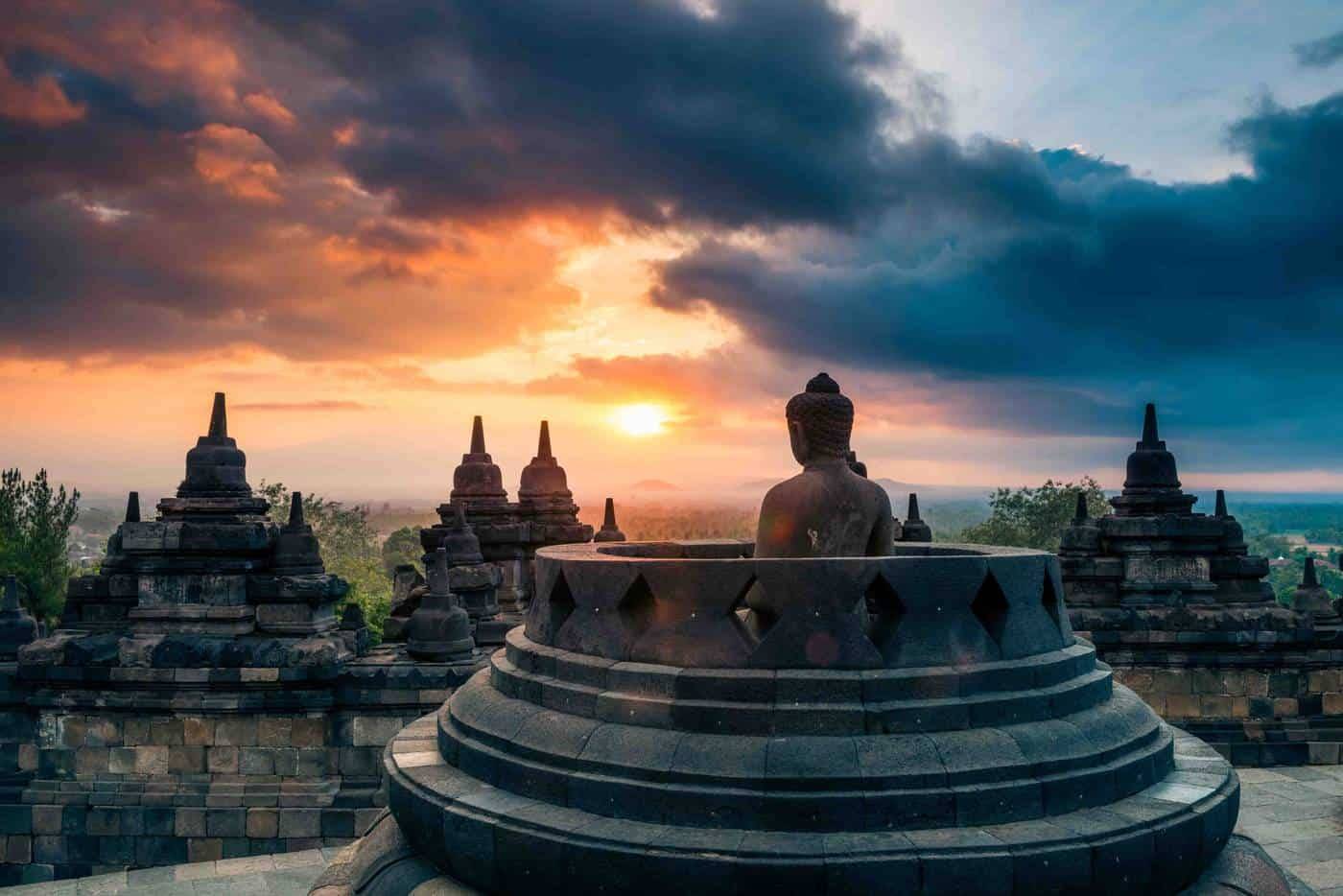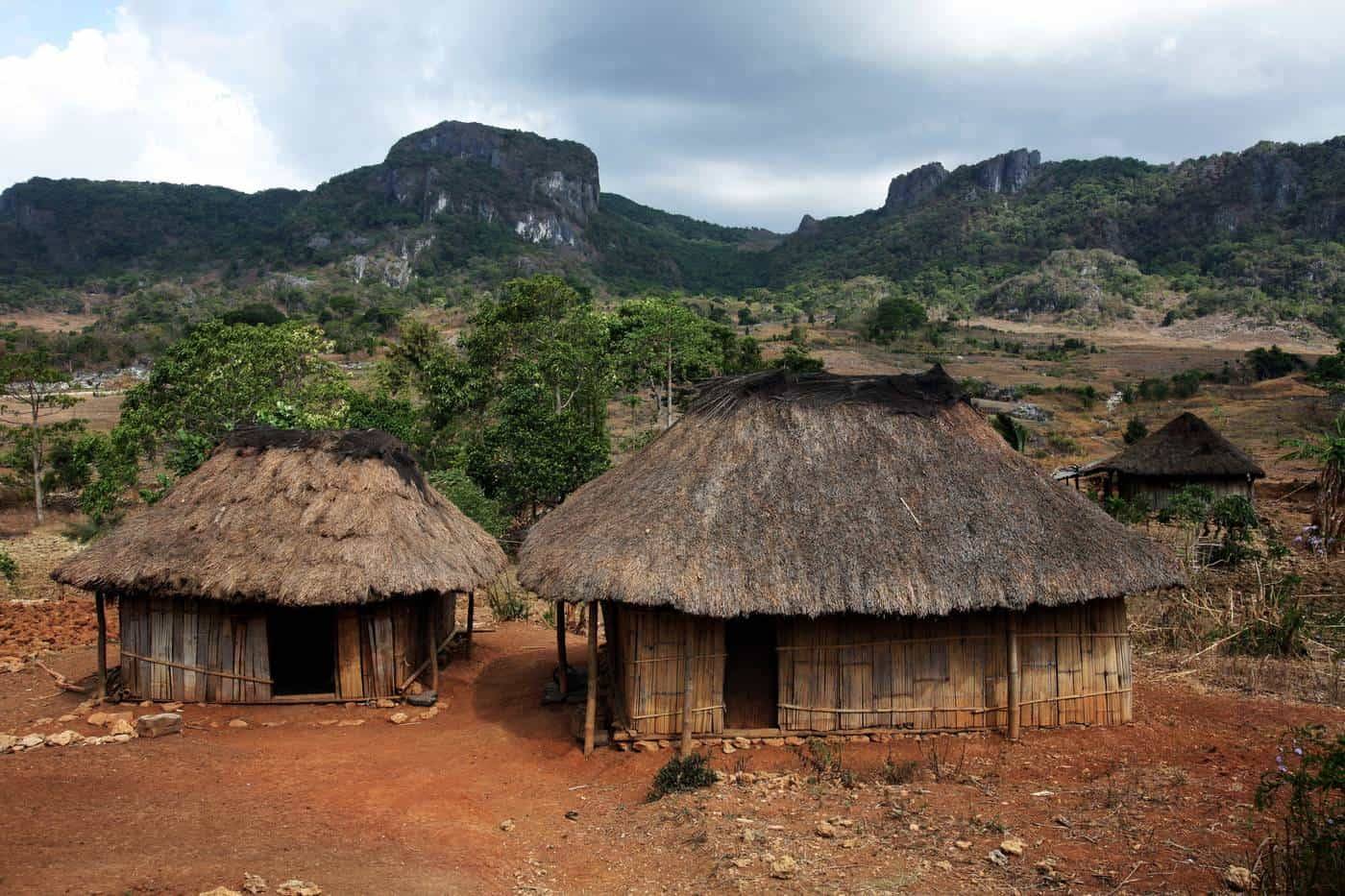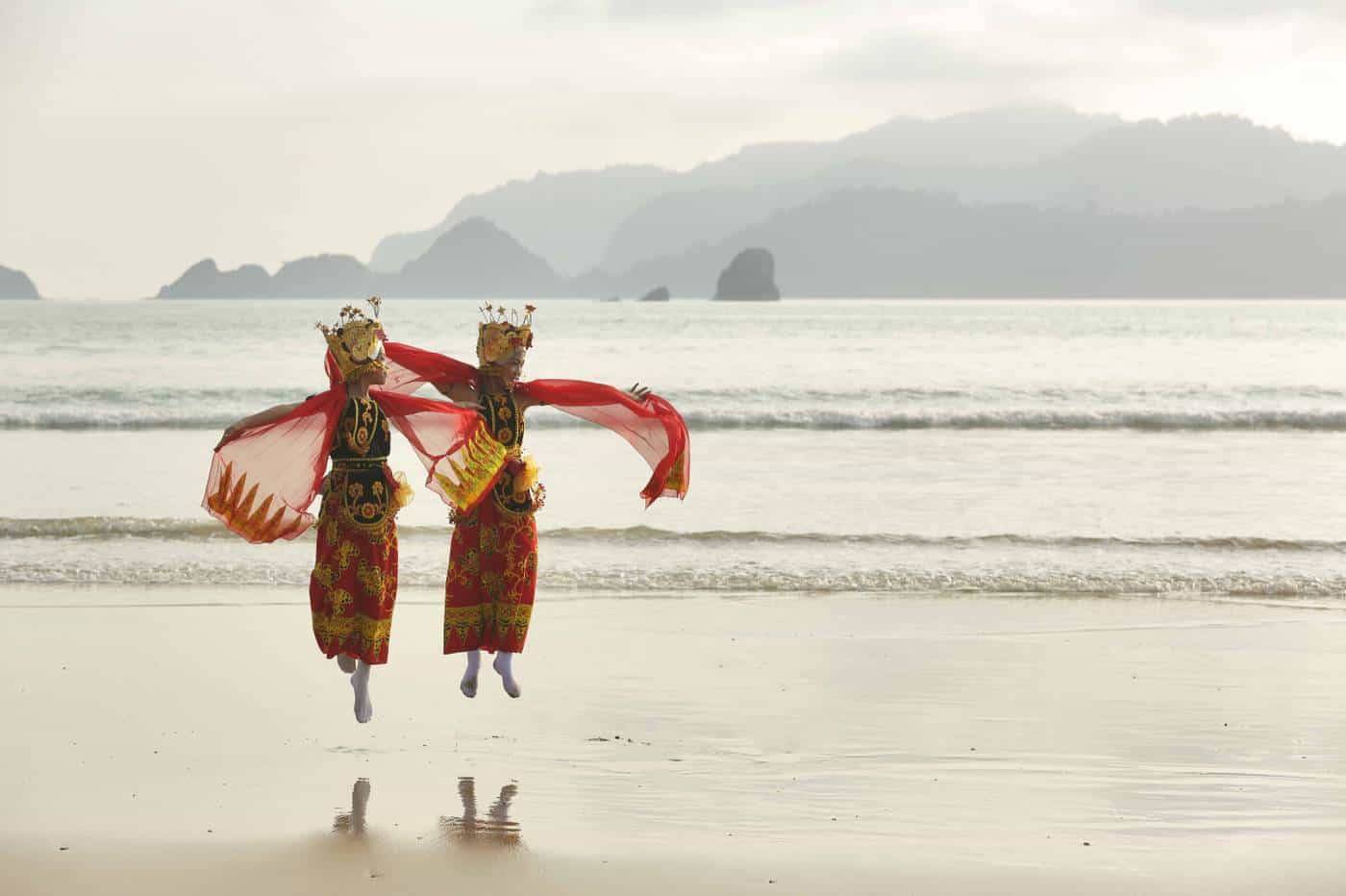
THE WILD GRACE OF BANYUWANGI
SOPHISTICATED CUTLURE
Quite similar to the Balinese folk, the Banyuwangi culture has a strong art spirit, and the local artwork is defined by grace, creativity, attention to detail and unique techniques, and whether it comes to painting, weaving, carving or music and dance the product is always of a high-quality.
The phenomenal spectacle of Gandrung and traditional theatre truly are overwhelming, and the everyday practice of white magic is believed to bring love and peace for everyone. Gandrung is a graceful female dance accompanied by violin, kluncing, kempul and kendhang music instruments, typically performed during the night until dawn, at celebrations.
NATURAL GRANDEUR
Banyuwangi is not only filled with artistry but also natural wealth and great wilderness. The Diamond Triangle includes some of the top attraction in Java – Kawah Ijen, Baluran, Meru Betiri and Alas Purvo – and offers a magnificent journey through impressive volcano craters, the last habitat of the Javan Tiger, the authentic ‘Indonesian Safari’ and the world-class surfing locations.
And if none of these has drawn your attention, Banyuwangi`s scenery is topped up with picturesque coffee plantations, tropical waterfalls, pristine rivers and striking beaches.
BANJUWANGI CITY
The centre of the region is the port town of Banyuwangi, with the backdrop of the volcanic Ijen Plateau to the west and beautiful island of Bali from the other side.
It is a transit corridor to Bali and gateway to all attractions in the province. Most importantly, it is the starting point to the most notable volcano in Indonesia – Kawah Ijen.
KAWAH IJEN
The Ijen Volcano attracts thousands of visitors every year with its one-kilometre-wide turquoise crater lake with a blue fire burning inside. This is an amazing creation of Mother Earth – the world`s largest acid lake with pH of 0.5 (sunrise tour is the best for the electric blue flame radiating out of the crater lake – visible only by night).
However, this volcanic marvel has got a flipside; the lake serves as labour-intensive sulfur mining operation – all conducted by bare hands of the local miners. Although the work is well-paid is it onerous and causing serious health issues.
TO GET THERE: Kawah Ijen crater can be reached from either 1.Banyuwangi (take a night tour all-inclusive, easy access, short and comfortable trip) or 2.Bondowoso (you will need to hire a guide with 4WD to reach the village of Wonosari/Jampit (Pos Paltuding). From there it is 1-2 hr hike up to the crater. This is usually an overnight trip with camping, longer route but more scenic – waterfall & coffee plantations on the way).
NOTE you can also hire a scooter at the Banyuwangi ferry terminal and travel independently (if arriving from Bali).
BOOK A TOUR OR TRAVEL INDEPENDENTLY
Both approaches (Bandowoso & Banyuwangi) are via Pos Paltuding point where you can find a campground to stay at. Independent travellers are free to get here without a guide, using a hired 4×4 vehicle, but it is rather a hustle.
Blue lights can be seen between 1-4 am, and you will need to have your own headlamp, good shoes, warm clothes and a gas mask.
The entrance office opens at 1 am where you can buy a ticket and rent the essential equipment. However, the tours are given priority, so if you travel on your own, you will need to wait until the crowds of tourists are served first (that might take up to 1 hr).
The hike itself can take up to 2 hours. Hence it will not allow you much time to appreciate the light spectacle only visible until sunrise (4 am). Therefore, an all-inclusive tour from Bandowoso or Banyuwangi is recommended for your convenience.
BONDOWOSO
Making the western entrance to Kawah Ijen, Bondowoso is an ancient city with significant historical heritage (ancient sites and Dutch colonial buildings). It is also the base to most of the regional points of interest.
Set amidst conical volcanoes, rice and coffee plantations and tropical rainforest, the city features both natural attractions and sightseeing.
The town of Bondowoso is encircled by volcanoes of Gunung Raung, Gunung Argopuro and Kawah Ijen, among which Mt Raung is often climbed ( 8 hr with a porter) while Mt Argopuro is some of the toughest hikes in Indonesia (4-6 day expedition).
There are many lovely waterfalls in the area, e.g. Tancak Kembar, Tancak Madures, Tancak Dawuhan, Tancak Aren and Tancak Patirana (all are easily accessible via a motorbike and short trek).
ESSENTIAL EXPERIENCES IN BONDOWOSO
- Bondowoso Old Town – explore the colonial buildings, mosques and museums and visit the Tourist Office to get some information about the surrounding attractions
- Kawah Ijen Crater – visit the world`s largest acid lake with pH of 0.5
- Mount Raung (3332 m) – climb this spectacular giant, one of the most active volcanoes in Indonesia (2-day hike)
- Mount Argopuro (3088 m) – the longest hike in Java (traverses across 40 km/4-6 day track)
- Puncak Megasari – absolutely breathtaking sunrise with the Kawah Ijen in the background (the best way to enjoy the views is paragliding)
- Bosamba River – perfect for rafting
- Kawah Wurung – mountain biking (down-hill)
- Sempol – hot springs, coffee plantations (also Sukosari)
- Ancient sites – Kening Stone, sarcophagi, gravestones (in Grujungan, Cerme, Maesan and Wringin)
- Eco-tourism & handicraft – batik (Maesan, Tamanan), pottery (Sumber Kemuning), silverwork (Cindogo), wood carving (Gunung Anyar Tapen), regularly held gamelan orchestra performances in Prajekan
- White Magic & natural healing – authentic dukun (local shaman & natural healer) performs everyday rituals and healing in Kalianyar village (also open for the Westerners)
ALAS PURWO NATIONAL PARK
The south-easternmost tip of Java belongs to the Blambangan Peninsula – made up by the stunning Alas Purwo National Park.
The reserve is home to the endangered Banteng (wild cattle) and other rare species of fauna as well as untouched mangroves, savanna and lowland monsoon forest.
Besides, this is where the best surfing location in Java can be found.
Plengkung Beach is famous for fantastic waves, especially the G-land, Money Trees, Twenty-Twenty and Tiger Waves and the annual international surfing competition (held in May).
Bedul Beach, on the other hand, is mostly visited by nature lovers. It is a popular eco-tourism area in the Gradjagan Bay.
Traditional boats depart daily from Sumberasri village to the Mangrove Bedul Ecotourism. The coastal mangroves are home to migrating birdlife and wildlife.
TO GET THERE: the entrance to the park is at the Trianggulasi village where you can camp or stay at one of the guesthouses (there are both good accommodation and facilities for surfers in the Plengkung Beach area). To get to G-land (Plengkung Beach) take a bus from Banyuwangi to Gradjagan or rent a motorbike in and travel independently (2 hrs drive).
BALURAN NATIONAL PARK (‘LITTLE AFRICA’)
Often dubbed as ‘Little Africa’, the north-eastern end of the country is typical of acacia savanna dotted with grazing herds of wildlife, and indeed, the reserve could be easily confused with any other one in Africa.
There are many Safari tours across Indonesia available to tourists, yet this is the only one that truly justifies the meaning of the word ‘Safari’, especially the panoramic view from the Bekol Savannah point.
The grassland of Baluran National Park is picturesquely hugging the dormant volcano of Gunung Baluran (1247 m) whereas the coastal territories are covered with monsoon forest and mangrove.
The national park has pristine beaches with undisturbed coral reefs (e.g. Bama Beach with good snorkelling) and abundant fauna, including Javan deer, the endangered Banteng buffalo, various species of primates, wild boar, leopard cat and radiant birdlife.
For the best views, climb Mount Baluran (the volcano is rarely climbed but worth of the effort, local guide recommended).
TO GET THERE: from Banyuwangi ferry terminal or city centre by scooter/vehicle (independently, easy access) or book an eco-tour. The entrance to the park is at Batangan (35 km from Banyuwangi).
MERU BETIRI NATIONAL PARK
The Meru Betiri forest is magnificent wildlife sanctuary and the last known habitat of the Javan Tiger, with the latest sighting in 1976.
Today, the species is considered extinct, and the reserve is home to many other protected animals, e.g. Sukamede Beach is a large breeding station for sea turtles that visit the beach almost every night.
With varied topography, from the sandy coastal plains to the jungly highlands, there is great wilderness to explore.
Apart from splendid beaches of Meru, Bandealit, Permisan and Rajegwesi, the dense rainforest provides good conditions for water sports, biking and trekking, particularly at the Sukamade River.
At the eastern entrance to the national park, there is spectacular coastline scenery to admire Pesanggaran. Particularly, the Pantai Pulau Merah (the Red Island Beach), Pantai Badug Beach and the Green Bay are fantastic for surfing, walking and photography.
Hire a scooter and drive to the town of Pesanggaran via Genteng; that will allow you to search around the secluded coves at your own pace. If you are a surfer try to catch a wave, there are nice surf camps in the area, too.
At the western end of Meru Bitiri reserve, there are magnificent open Indian Ocean beaches to visit: Pantai Watu Ulo Beach and Pantai Papuma (access from Jember).
TO GET THERE: from Banyuwangi ferry terminal or city centre by scooter/vehicle or by bus to Pesanggaran – the gateway to the Sukamede Beach, Pantai Pulau Merah etc. (2 hrs drive)
ESSENTIAL EXPERIENCES IN BANYUWANGI (BRIEF SUMMARY)
- Kawah Ijen Crater – visit the world`s largest acid lake with pH of 0.5 (sunrise tour is the best due to the blue flame radiating out of the crater lake
- Bondowoso – sightseeing, Mt Raung volcano climb, outdoor activities, water sports, coffee plantations, art & craft, eco-tourism
- White magic and shamanic healing – in the Bondowoso countryside, e.g. Kalianyar village (also open for the Westerners)
- Muncar – a charming fishing village with radiant market, it is the sunrise capital of Java
- Alas Purwo National Park – stunning tropical lowland forest with abundant wildlife
- Plengkung Beach/Gradjagan Bay – the famous G-land/, Money Trees, Twenty-Twenty and Tiger Waves spots offer world-class surf between April and October)
- Bedul Beach/Gradjagan Bay – gorgeous mangroves, river inlet, turtle sanctuary, scenic landscape
- Baluran National Park – the “Little Africa” of Indonesia, forested coastal park with deserted beaches, open savanna with rich fauna and flora, the authentic Indonesian Safari (easy access from Bali)
- Pulau Tabuhan – popular diving location near Bali, offshore corals, exotic birds (boat access from Tambak Kampe Beach, 30 min)
- Meru Betiri National Park – last recorded habitat of the Javan Tiger, Sukamede Turtle Breeding Station, Sukamede River, jungle trekking
- Papuma Beach – visit the traditional fishing town of Papuma known for radiant boats (fantastic for sunsets and photography)
- Pesanggaran – the Indian Ocean coast is known for the magnificent Pantai Pulau Merah (the Red Island Beach), Pantai Badug and the Green Bay, fantastic for surfing, walking and photography
- Gandrung dance – watch the rice harvest dance performances and see one of the local magicians of Banyuwangi to learn more about their powers (performances can be watched in the town of Banyuwangi
WHEN TO TRAVEL
The dry season in Java generally runs from May till October with peak tourist season in July and August (try to avoid these months as the prices go up and most of the places are overcrowded).
Good time to visit Java seems May-June and Sep-Oct. However, rain can occur at any time in this part of the world. Also, weekends and local public and school holidays will be very busy.
HOW TO GET THERE
From Bali: from Banjuwangi ferry terminal (if travelling from Bali), take a bus/ojek to the entrance of the desirable park or book a tour in Banyuwangi town. Optionally, rent a 4WD vehicle to explore the neighbourhood independently. To move around locally hire a scooter.
From Java: catch a bus in Surabaya, Malang or Probolinggo to any of the above-mentioned destinations.
For all international flights visit www.momondo.com or www.skyscanner.com
For all domestic Indonesian flights check out www.garuda-indonesia.com
